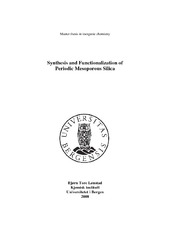Synthesis and Functionalization of Periodic Mesoporous Silica
Master thesis
Permanent lenke
https://hdl.handle.net/1956/3117Utgivelsesdato
2008Metadata
Vis full innførselSamlinger
- Department of Chemistry [433]
Sammendrag
Different periodic mesoporous silica materials have been synthesized in order to investigate the topic of size-selective heterogeneous catalysis. SBA-1, SBA-2, SBA-16, and MCM-41 were synthesized. The cagelike SBA-1 and the channel-like MCM-41 have been modified by post-synthesis methods involving grafting of HN(SiHMe)2, HN(SiMe2Ph)2, and HN(SiMePh2)2 to tailor the surface for subsequent metalation reactions. The three disilazanes showed different reactivity to the two different topologies involving also of SBA-1 pore blocking. {Mg[N(SiHMe2)2]2}2 was synthesized and grafted onto the surface. The immobilized magnesium complex gave pore characteristics similar to those of the largest disilazane. Ti(NMe2)4 was chosen as a “small” transition metal complex and gave materials with around 10 weight % titanium. R-1,1’-binaphthol was used to exchange the amido ligands of the grafted titanium complex, but gave only the expected exchange on MCM-41 and not on SBA-1 which may be due to the small cage window of this material. Ti(NMe2)3[N(SiHMe2)2] was synthesized and grafted on the surface for use as a spectroscopic probe in FT-IR spectroscopy. Metalorganic complexes were characterized by 1H and 13C NMR spectroscopy, DRIFT or FT-IR spectroscopy, and elemental analysis. Materials were characterized by powder X-ray diffraction, nitrogen physisorption, DRIFT or FT-IR spectroscopy and elemental analysis.
Utgiver
The University of BergenOpphavsrett
The authorCopyright the author. All rights reserved
